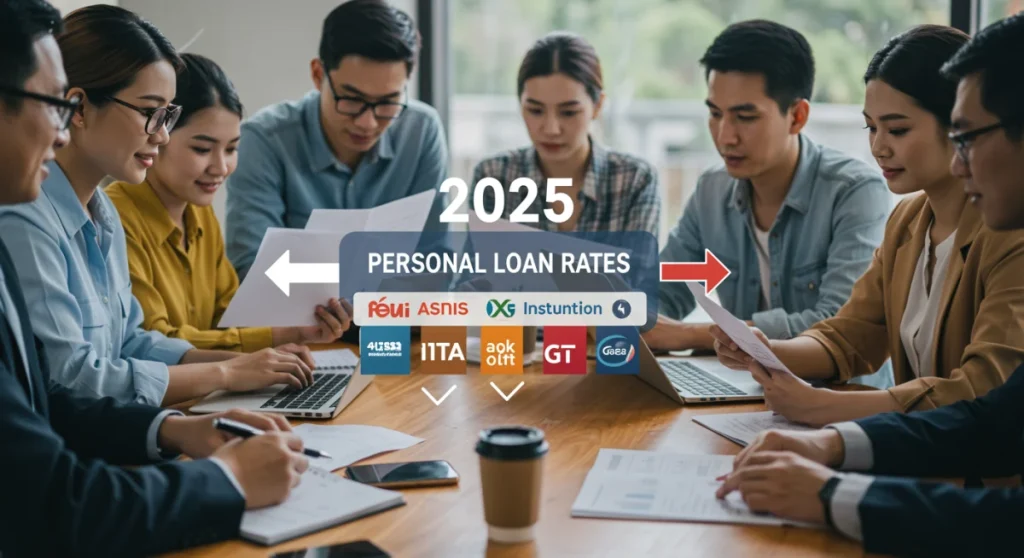Personal Loan Rates 2025: Top US Lenders Compared

Navigating personal loan rates in 2025 requires understanding diverse offerings from top US lenders, as interest rates, fees, and eligibility criteria vary significantly, impacting overall borrowing costs and suitability for individual financial needs.
As we step into 2025, understanding personal loan rates is more crucial than ever for US consumers looking to finance major purchases, consolidate debt, or cover unexpected expenses. The financial landscape is constantly evolving, and what constituted a competitive rate last year might be different this year. This comprehensive guide delves into the offerings of five prominent lenders, providing a comparative analysis to help you make informed decisions about your borrowing needs.
Understanding personal loan rates in 2025
The world of personal loans can seem complex, but at its core, it’s about borrowing money and paying it back with interest. In 2025, several factors continue to influence these rates, making it essential for consumers to be aware of the market dynamics. From economic indicators to individual credit profiles, every element plays a role in determining the final cost of your loan.
Interest rates are essentially the cost of borrowing money, expressed as a percentage of the loan amount. These rates can be fixed, meaning they stay the same throughout the loan term, or variable, meaning they can fluctuate. Most personal loans offer fixed rates, providing predictability in monthly payments.
Key factors influencing your personal loan rate
- Credit Score: This is arguably the most significant factor. Lenders use your credit score to assess your creditworthiness. A higher score typically leads to lower interest rates, as it indicates a lower risk of default.
- Debt-to-Income Ratio: This ratio compares your monthly debt payments to your gross monthly income. A lower ratio suggests you have more disposable income to cover loan payments, making you a more attractive borrower.
- Loan Term: The length of time you have to repay the loan. Shorter terms often come with lower interest rates but higher monthly payments, while longer terms have higher overall interest costs but smaller monthly payments.
- Loan Amount: The principal amount you wish to borrow can also influence the rate. Some lenders offer better rates for larger loan amounts, while others might have minimum and maximum thresholds.
Understanding these factors empowers you to improve your financial standing before applying for a personal loan, potentially securing more favorable terms. It’s not just about finding the lowest advertised rate; it’s about finding the lowest rate you qualify for based on your individual financial situation.
In conclusion, personal loan rates in 2025 are a reflection of both broader economic conditions and your personal financial health. Taking the time to understand these underlying factors can significantly impact the affordability and suitability of any loan you consider.
Lender comparison: Bank A’s competitive edge
Bank A has consistently positioned itself as a strong contender in the personal loan market, especially for consumers with excellent credit. Their offerings in 2025 continue to reflect a commitment to competitive rates and flexible terms, making them a go-to option for many.
For individuals boasting a strong credit history, Bank A often provides some of the lowest advertised annual percentage rates (APRs). This makes them particularly appealing for debt consolidation, where even a small reduction in interest can lead to significant savings over the life of the loan. Their application process is streamlined, often allowing for quick pre-qualification without impacting your credit score.
What sets Bank A apart
- Low APRs for top-tier credit: Consumers with FICO scores above 740 may find Bank A’s rates highly attractive.
- No origination fees: Unlike some lenders, Bank A typically does not charge an upfront fee for processing the loan, which can save borrowers a substantial amount.
- Flexible loan amounts: They offer a wide range of loan amounts, catering to various financial needs, from small personal expenses to larger debt consolidation efforts.
While Bank A shines for those with excellent credit, it’s important to note that their rates may not be as competitive for borrowers with average or fair credit scores. Their focus appears to be on attracting low-risk clients, which in turn allows them to offer those borrowers more favorable terms. Potential applicants should always check their own credit score before approaching Bank A to set realistic expectations.
In essence, Bank A remains a top choice for well-qualified borrowers seeking competitive personal loan rates in 2025, distinguished by their low APRs and transparent fee structure.
Lender comparison: Exploring Bank B’s offerings
Bank B has carved out its niche by offering a balanced approach to personal loans, often appealing to a broader spectrum of consumers than some of its more exclusive counterparts. In 2025, their product suite continues to emphasize accessibility alongside competitive pricing, making them a significant player in the market.
One of Bank B’s notable features is its willingness to consider applicants with good to excellent credit, not just the absolute top tier. This broader eligibility can be a huge advantage for many US consumers who have solid financial habits but perhaps don’t have a perfect credit score. Their rates, while perhaps not always the absolute lowest for prime borrowers, are consistently competitive and fair across their approved credit tiers.
Bank B’s customer-centric approach
- Competitive rates for good credit: Bank B often provides attractive rates for individuals with FICO scores in the 670-739 range, bridging the gap between prime and subprime lenders.
- Various repayment options: They offer a range of repayment terms, allowing borrowers to choose a schedule that best fits their budget and financial goals.
- Strong customer support: Many reviews highlight Bank B’s robust customer service, which can be invaluable when navigating the loan application and repayment process.
Furthermore, Bank B is known for its relatively quick funding times once an application is approved. This can be a critical factor for individuals who need access to funds promptly for emergencies or time-sensitive projects. While they may have origination fees in some cases, these are generally transparently disclosed upfront, allowing borrowers to factor them into their overall cost analysis.
To summarize, Bank B offers a compelling option for personal loans in 2025, particularly for those with good credit who value a combination of competitive rates, flexible terms, and reliable customer service.
Lender comparison: Credit Union C’s community focus
Credit Union C stands out in the personal loan landscape of 2025 due to its cooperative structure and community-oriented philosophy. Unlike traditional banks, credit unions are member-owned, often translating into more favorable rates and personalized services for their members. This approach can make Credit Union C an excellent choice for those seeking a more human touch in their financial dealings.
Their personal loan rates are frequently competitive, sometimes even lower than those offered by large banks, especially for members who have a long-standing relationship with the credit union. The eligibility criteria might also be more flexible, as credit unions often take a holistic view of a member’s financial situation rather than relying solely on credit scores.

Advantages of choosing Credit Union C
- Lower interest rates: As non-profit organizations, credit unions can often offer lower rates on loans and higher rates on savings accounts.
- Personalized service: Members often report a more individualized and understanding approach to loan applications and financial advice.
- Flexible eligibility: While credit scores are still important, Credit Union C may be more willing to work with members who have less-than-perfect credit, especially if they demonstrate a commitment to financial improvement.
However, it’s important to remember that membership is typically required to access Credit Union C’s services. This usually involves meeting specific geographic or affiliation criteria. While joining is often straightforward, it’s an extra step compared to applying at a traditional bank. Despite this, the potential savings and community benefits often outweigh the initial membership requirement.
Ultimately, Credit Union C presents a strong alternative for personal loans in 2025, particularly for those who value lower rates, personalized service, and a community-focused financial institution.
Lender comparison: Online Lender D’s rapid solutions
Online Lender D has surged in popularity by offering quick and convenient personal loan solutions, a crucial aspect for consumers in 2025 who prioritize speed and efficiency. Their entirely digital platform streamlines the application process, often providing instant decisions and rapid funding, making them ideal for urgent financial needs.
This lender typically caters to a wide range of credit profiles, from excellent to fair, though rates will vary significantly based on creditworthiness. Their strength lies in their technology-driven approach, which allows for lower overheads compared to traditional brick-and-mortar institutions, sometimes translating into competitive rates for certain segments of borrowers.
The benefits of choosing Online Lender D
- Fast application and approval: The online process is designed for speed, with many applicants receiving decisions within minutes and funds within one to two business days.
- Wide credit score acceptance: While the best rates go to those with higher scores, Online Lender D is known to work with a broader spectrum of credit profiles.
- Convenience: The entire process, from application to managing the loan, can be done online, offering unparalleled convenience for busy consumers.
It’s important for potential borrowers to carefully review all terms and conditions, as some online lenders might have higher APRs or additional fees compared to traditional banks, especially for those with lower credit scores. However, for sheer speed and ease of access, Online Lender D is often hard to beat. Their transparency in displaying loan terms and costs is also a key factor in their appeal.
In summary, Online Lender D is an excellent option for personal loans in 2025 for those who value a rapid, fully digital experience and need quick access to funds, even if it means potentially paying a slightly higher rate depending on their credit profile.
Lender comparison: Fintech E’s innovative approach
Fintech E represents the cutting edge of personal lending in 2025, leveraging advanced algorithms and data analytics to offer highly personalized loan products. This innovative approach often translates into unique benefits for borrowers, particularly those who might not fit the mold of traditional lending criteria.
What sets Fintech E apart is its ability to assess creditworthiness beyond just a FICO score. They might consider factors like banking history, employment stability, and even educational background to offer more tailored rates and terms. This can be particularly advantageous for younger borrowers or those with limited credit history who are otherwise financially responsible.
Fintech E’s unique advantages
- Alternative credit assessment: Utilizes a broader range of data points, potentially offering loans to individuals overlooked by traditional lenders.
- Personalized loan offers: Rates and terms can be highly customized based on a more comprehensive understanding of the borrower’s financial situation.
- User-friendly technology: Their platforms are typically intuitive and easy to navigate, making the application and management of loans a seamless experience.
While Fintech E’s innovative models can be a game-changer for many, it’s crucial for consumers to understand the specifics of their algorithms and how their data is used. Transparency around their decision-making process is key. Moreover, as newer entrants, some Fintech lenders might not have the same long-standing reputation as established banks, although many have quickly built trust through reliable service.
To conclude, Fintech E offers an exciting and often more inclusive route to personal loans in 2025, especially for those seeking a highly personalized borrowing experience driven by modern technology and alternative data insights.
| Lender Type | Key Advantage |
|---|---|
| Bank A | Lowest APRs for excellent credit, no origination fees. |
| Bank B | Competitive rates for good credit, strong customer support. |
| Credit Union C | Lower rates due to cooperative model, personalized service. |
| Online Lender D | Rapid application/funding, wide credit score acceptance. |
Frequently asked questions about personal loan rates in 2025
Generally, a FICO score of 670 or higher is considered good and will give you access to more competitive personal loan rates. Scores above 740 are often considered excellent and can unlock the very best rates from top lenders, including those with no origination fees.
Traditional banks like Bank A and B often offer lower rates for borrowers with excellent credit but may have stricter eligibility. Online lenders like D and Fintech E might offer broader accessibility and faster funding, sometimes at slightly higher rates, especially for those with average credit scores, due to their operational models.
Predicting exact rate movements is challenging, as they depend on the Federal Reserve’s monetary policy, inflation, and overall economic stability. While some fluctuations are always possible, 2025 is generally anticipated to see rates stabilize or experience moderate changes, making it crucial to compare offers before committing.
Beyond the interest rate, common fees include origination fees, which are upfront charges for processing the loan, and late payment fees. Some lenders may also charge prepayment penalties, though these are less common with personal loans. Always review the annual percentage rate (APR) as it includes most fees.
No, pre-qualification typically involves a soft credit inquiry, which does not impact your credit score. It allows you to see potential rates and terms without commitment. A hard inquiry, which may slightly lower your score, only occurs when you formally apply for the loan after deciding on a lender.
Conclusion
Navigating the landscape of personal loan rates in 2025 requires a discerning eye and a clear understanding of your financial profile and needs. From the competitive rates of traditional banks like Bank A for top-tier credit to the broader accessibility of Bank B, the community-focused advantages of Credit Union C, the rapid solutions from Online Lender D, and the innovative approaches of Fintech E, US consumers have a wealth of options. The key lies in comparing offers, understanding all associated fees, and choosing a lender whose terms align best with your financial goals. By taking an informed and proactive approach, you can secure the personal loan that not only meets your immediate needs but also supports your long-term financial well-being.





